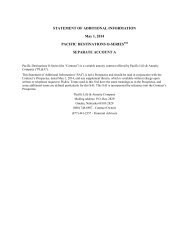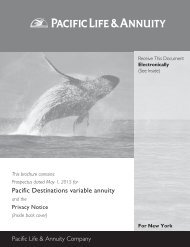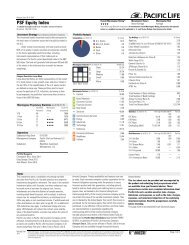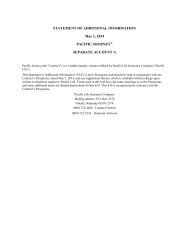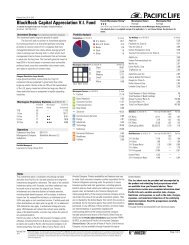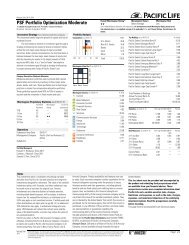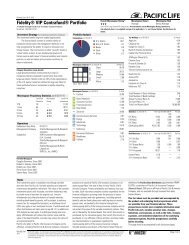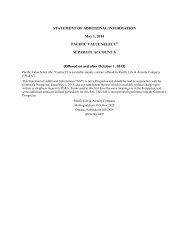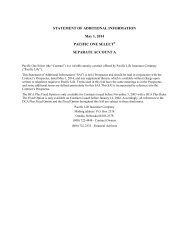PACIFIC DESTINATIONS® - Pacific Life Insurance Company
PACIFIC DESTINATIONS® - Pacific Life Insurance Company
PACIFIC DESTINATIONS® - Pacific Life Insurance Company
Create successful ePaper yourself
Turn your PDF publications into a flip-book with our unique Google optimized e-Paper software.
<strong>PACIFIC</strong><br />
DESTINATIONS ®<br />
Investor Guide<br />
A Variable Annuity to<br />
Help You Reach Your<br />
Retirement Goals<br />
5/15<br />
33001-15A
Contents<br />
<strong>Pacific</strong> <strong>Life</strong> has more<br />
than 145 years of<br />
experience, and we<br />
remain committed<br />
to providing quality<br />
products, service,<br />
and stability to meet<br />
your needs today<br />
Make the Most of Your Retirement .....................................................2<br />
Who’s Who in an Annuity? ......................................................................3<br />
The <strong>Pacific</strong> Destinations Advantage ....................................................4<br />
Grow and Manage Savings Tax-Efficiently ........................................6<br />
The Power of Tax Deferral....................................................................... 7<br />
Steady Income Payments .........................................................................8<br />
Help Provide for Your Heirs ..................................................................10<br />
Getting Started ..........................................................................................12<br />
Our Focus Is on You ...............................................................Back cover<br />
and throughout<br />
your lifetime.<br />
<strong>Insurance</strong> products are<br />
issued by <strong>Pacific</strong> <strong>Life</strong><br />
<strong>Insurance</strong> <strong>Company</strong> in all<br />
states except New York<br />
and in New York by<br />
<strong>Pacific</strong> <strong>Life</strong> & Annuity<br />
<strong>Company</strong>. Product<br />
availability and features<br />
may vary by state.<br />
No bank guarantee<br />
Not a deposit • May lose value<br />
Not FDIC/NCUA insured<br />
Not insured by any federal<br />
government agency
Why <strong>Pacific</strong> <strong>Life</strong><br />
It’s essential for you to choose a strong and stable company that can help you achieve your future<br />
income needs. Since 1868, individuals and their families have relied on the strength of <strong>Pacific</strong> <strong>Life</strong><br />
to help protect their financial security.<br />
• <strong>Pacific</strong> <strong>Life</strong> <strong>Insurance</strong> <strong>Company</strong> is organized under a mutual holding company structure and<br />
operates for the benefit of its policyholders and contract owners.<br />
• We have achieved ongoing recognition 1 for high-quality service standards.<br />
• We offer products that address market environments during all stages of your life.<br />
• We maintain strong financial strength ratings from major independent rating agencies.<br />
Ratings may change and do not apply to the safety or performance of the underlying variable<br />
investment options. For more information and current financial strength ratings, please visit<br />
our website.<br />
1<br />
Recipient of multiple DALBAR Service Awards since 1997. Refer to www.DALBAR.com for more information regarding awards,<br />
certification, and rankings.<br />
1
Make the Most of<br />
Your Retirement<br />
In the future, more time will be spent in retirement. It’s important to plan ahead to help you achieve your<br />
retirement goals.<br />
A variable annuity, a long-term contract between you and an insurance company, can be an important<br />
part of a retirement strategy. It’s an investment that can provide lifetime income and death benefits as well<br />
as the ability to transfer among investment options tax-free.<br />
A variable annuity offers you the potential to outpace inflation as you grow your assets. You also are able<br />
to choose how much and where to invest as well as when to start taking income. Your income is available<br />
through withdrawals, or you can convert your contract to annuity income payments (standard payout<br />
options). Think of it as a personal retirement investment that you control.<br />
2
Who’s Who<br />
in an Annuity?<br />
3<br />
It’s important to know who the key parties are in an annuity contract.<br />
Owner<br />
The owner makes the decisions about the annuity, such as how much money to put into the contract.<br />
The owner also names the annuitants and the beneficiaries.<br />
Annuitant<br />
The owner and the annuitant may or may not be the same person. Either way, it’s the annuitant’s life<br />
expectancy that is used to set the dollar amount of future annuity income.<br />
Beneficiary<br />
If the owner or annuitant dies before income payments begin, usually, the beneficiary is the one who may have<br />
the right to receive the death benefit.<br />
There may be one or more owners, annuitants, and beneficiaries.
The<br />
<strong>Pacific</strong> Destinations®<br />
Advantage<br />
Lower Costs Over the Long Term<br />
Designed for long-term retirement needs, <strong>Pacific</strong> Destinations offers you more opportunity for growth<br />
through lower mortality and expense, and administrative fees over the life of your contract. For additional<br />
information on sales charges, please refer to Getting Started on page 12.<br />
4
No Surrender Charges<br />
Although a withdrawal may reduce your guaranteed income and account value, you will never pay a surrender<br />
charge on a withdrawal. Keep in mind that withdrawals and other distributions of taxable amounts, including<br />
death benefit payouts, will be subject to ordinary income tax. For nonqualified contracts, an additional 3.8%<br />
federal tax may apply on net investment income. If taken prior to age 59½, an additional 10% federal tax may<br />
apply. Withdrawals will reduce the contract value and the value of the death benefits, and also may reduce the<br />
value of any optional benefits.<br />
5
Grow and Manage<br />
Savings Tax-Efficiently<br />
A variable annuity is a tax-deferred investment. In a taxable investment, part of your earnings—including<br />
dividends, interest, and capital gains—may be lost to taxes each year. But in a tax-deferred variable annuity,<br />
there are no taxes on earnings until you decide to withdraw funds or receive guaranteed retirement<br />
income payments. That means you can grow savings faster, make time work for you, and make decisions<br />
without tax consequences.<br />
Grow Savings Faster<br />
Imagine that you start pouring water into two empty glasses—but one has a leak. In which glass will the<br />
water rise faster? Annual taxation is like a leak in your retirement savings. Every year, taxes drain away a<br />
portion of those savings. However, a variable annuity is tax-deferred. Taxes are not due until you withdraw<br />
funds or use them for retirement income. This can help the account value rise faster than money in a<br />
taxable investment, as illustrated by the example on the next page.<br />
Make Time Work for You<br />
The longer you allow tax deferral to work, the more powerful it can be. In our hypothetical example,<br />
the after-tax difference between the two investments is approximately $2,850 after 10 years<br />
($145,280 – $142,429). But if held for 20 years, the difference is more than $16,000 ($219,037 – $202,859).<br />
Make Decisions without Tax Consequences<br />
Transfers among variable annuity investment options are tax-free. So as your life and needs change, your<br />
investment strategy can change also. Rebalancing your portfolio is also tax-free, enabling you to keep your<br />
investments in-line with your original asset allocation strategy.<br />
6
The Power of Tax Deferral<br />
These glasses illustrate the way a hypothetical investment of $100,000 would grow in a taxed versus<br />
tax-deferred investment if each earns 5% per year and is taxed at a 28% ordinary income tax rate.<br />
The amount inside the glass represents the growth in the hypothetical $100,000 after 10 and 20 years.<br />
10 Years<br />
After 10 Years<br />
Taxed<br />
Tax-Deferred<br />
Amount after taxes<br />
are paid annually<br />
for 10 years.<br />
$142,429<br />
$162,889<br />
$145,280<br />
Full amount before taxes.<br />
Amount withdrawn<br />
after taxes paid at<br />
the end of 10 years.<br />
10 Years<br />
Taxed<br />
After 20 Years<br />
Tax-Deferred<br />
$265,330<br />
Full amount before taxes.<br />
Amount after taxes<br />
are paid annually<br />
for 20 years.<br />
$202,859<br />
$219,037<br />
Amount withdrawn<br />
after taxes paid at<br />
the end of 20 years.<br />
Actual tax rates may vary for different taxpayers and assets from those illustrated (for example, capital gains and qualified dividend income).<br />
Actual performance of your investment will also vary. Lower maximum tax rates on capital gains and dividends would make the investment<br />
return for the taxable investment more favorable, thereby reducing the difference in performance between the examples shown. Consider<br />
your personal investment time horizon and income tax brackets, both current and anticipated, when making an investment decision.<br />
Hypothetical returns are not guaranteed and do not represent performance of any particular investment. If <strong>Pacific</strong> Destinations charges were<br />
included [0.60% mortality and expense risk, 0.15% administrative fee, underlying fund expenses, a $30 annual contract fee (waived if contract<br />
value is $50,000 or more), and a 5.5% up-front maximum sales charge], the tax-deferred performance would be significantly lower.<br />
The value of the variable investment options will fluctuate and, when redeemed, may be worth more or less than the original cost. Annuity<br />
withdrawals and other distributions of taxable amounts, including death benefit payouts, will be subject to ordinary income tax. For nonqualified<br />
contracts, an additional 3.8% federal tax may apply on net investment income. If withdrawals and other distributions are taken prior to age 59½,<br />
an additional 10% federal tax may apply. Withdrawals will reduce the contract value and the value of the death benefits, and also may reduce<br />
the value of any optional benefits.<br />
IRAs and qualified plans—such as 401(k)s and 403(b)s—are already tax-deferred. Therefore, a deferred annuity should be used only to fund<br />
an IRA or qualified plan to benefit from the annuity’s features other than tax deferral. These include lifetime income, death benefit options,<br />
and the ability to transfer among investment options without sales or withdrawal charges. 7
Steady Income Payments<br />
After the first contract anniversary, you are automatically entitled to one of the following four standard<br />
annuity income options including some that pay for life. Choosing appropriately for your retirement strategy<br />
is important because once you convert your contract to annuity income, you cannot switch options. Amounts<br />
will differ based on the payout period selected. Usually, the longer the possible payout period, the lower the<br />
periodic payment amount. The minimum periodic income payment is $250 ($20 in New York), and your contract<br />
value must be at least $10,000 ($2,000 in New York). For qualifed contracts, the period chosen may not be<br />
longer than your life expectancy.<br />
Annuity Income Option<br />
<strong>Life</strong> Only<br />
<strong>Life</strong> with Period Certain<br />
Joint and Survivor <strong>Life</strong><br />
Period Certain Only<br />
You Receive<br />
Guaranteed income you can’t outlive<br />
Periodic payments for life are guaranteed.<br />
Guaranteed income you can’t outlive with beneficiary protection<br />
Periodic payments will be made for life and guaranteed for a minimum<br />
period of 5 to 30 years. If you die before the end of the period certain, your<br />
beneficiary will receive the remaining income. If you live longer than the<br />
period certain, you will continue to receive the income until you die.<br />
Income you and another person can’t outlive<br />
Periodic payments are guaranteed over your lifetime (as the primary<br />
annuitant) and the lifetime of another person (as the secondary annuitant).<br />
Guaranteed income over time<br />
Guaranteed periodic payments will be made over a specific period, from<br />
5 to 30 years.<br />
Guarantees are backed by the financial strength and claims-paying ability of the issuing insurance company.<br />
You can determine whether you want a fixed-dollar amount and/or a variable payout amount and how<br />
frequently you’ll receive your payments.<br />
8
Tax Advantages<br />
When you begin taking annuity income payments under one of the standard annuity income options, each<br />
income payment is composed of money that you’ve paid into the annuity plus any earnings. For qualified<br />
contracts, taxes will generally be due on the entire payout. For nonqualified contracts, taxes will be due only<br />
on the earnings portion. A formula unique to annuities determines the nontaxable portion of each payout<br />
until all the money you put into the contract has been taken out. Due to the formula, nonqualified income<br />
payments are tax-advantaged—which means that your tax liability is spread out over time. The actual tax<br />
impact will depend on your annuity income option, gender, age, and tax bracket.<br />
Access to Your Money<br />
Instead of taking annuity income payments, you can remain invested and take withdrawals as needed. Because<br />
you can never predict the future, it’s comforting to have the ability to access your contract value when you<br />
need it. Withdrawals may begin as soon as 30 days after the date the contract was issued.<br />
You can set up a schedule of ongoing withdrawals or make periodic withdrawals, as needed, without charge.<br />
• Withdraw a minimum of $500 at any time.<br />
• Withdraw the full contract value, minus any applicable contract fees, charges, and debt.<br />
Annuity withdrawals and other distributions of taxable amounts, including death benefit payouts, will be<br />
subject to ordinary income tax. For nonqualified contracts, an additional 3.8% federal tax may apply on net<br />
investment income. If withdrawals and other distributions are taken prior to age 59½, an additional 10%<br />
federal tax may apply. Withdrawals will reduce the contract value and the value of the death benefits, and<br />
also may reduce the value of any optional benefits. Withdrawals cease after age 95 (the later of age 90 or<br />
the tenth contract anniversary in New York), and the contract must be converted to annuity payouts.<br />
9
Help Provide<br />
for Your Heirs<br />
While you’re probably focusing on how to enjoy your retirement savings, it’s important to think ahead and<br />
plan how to provide for your loved ones if you were to die unexpectedly. <strong>Pacific</strong> Destinations can help<br />
protect your beneficiaries with a guaranteed death benefit that can help you leave a financial legacy and may<br />
avoid the cost and delays of probate. The death benefit is payable prior to annuitization upon the death of<br />
a contract owner. For contracts owned by a non-natural owner (for example, a trust), the death benefit is<br />
payable upon the death of the first annuitant.<br />
Standard Death Benefit Payout<br />
At no additional cost, this death benefit offers the greater of:<br />
1. The contract value.<br />
2. The total of all purchase payments into the contract, adjusted for withdrawals. The adjustment is<br />
proportionate and may be more or less than the actual amount withdrawn.<br />
Stepped-Up Death Benefit<br />
For an additional annual fee of 0.20% (deducted daily), and available only at contract issue for owners<br />
and annuitants age 75 or younger, this optional death benefit offers the greater of the standard death<br />
benefit detailed above or the highest step-up, which is the highest contract value on any previous contract<br />
anniversary prior to the oldest owner or annuitant’s 81 st birthday. The death benefit amount is increased<br />
for additional purchase payments and decreased by an adjustment for withdrawals. The adjustment is<br />
proportionate and may be more or less than the actual amount withdrawn.<br />
Earnings Enhancement Death Benefit (EEDB)<br />
For an additional annual fee of 0.25% (deducted annually), and available only at contract issue for owners<br />
and annuitants age 75 or younger, this optional death benefit may provide an enhancement to death benefit<br />
payouts. When EEDB is purchased, an additional 40% of earnings (oldest owner or annuitant age 0–69<br />
at issue) or 25% of earnings (oldest owner or annuitant age 70–75 at issue) is added to the death benefit<br />
amount. Earnings are equal to the contract value on the date of death minus remaining purchase payments.<br />
10
If you purchase this optional benefit, an annual charge will be deducted from your contract value on each<br />
contract anniversary. The contract must have growth in excess of the remaining purchase payments in order<br />
for EEDB to be applicable. If there are no earnings in the contract, no benefit will be paid, and you will have<br />
incurred the charge but not received a benefit. The EEDB amount is treated as earnings and may be taxable.<br />
In addition, the EEDB amount may affect the beneficiary’s adjusted gross income and marginal income-tax<br />
bracket. Withdrawals from the contract will reduce any earnings and decrease the EEDB amount. EEDB is<br />
not available in California or New York.<br />
Note that ownership changes may adversely affect the death benefit amounts detailed on pages<br />
10-11. See the prospectus for more information.<br />
The <strong>Pacific</strong> <strong>Life</strong> death benefits will be calculated on the Notice Date, which is the date we receive, in proper<br />
form, proof of death and instructions regarding payment of death benefit proceeds.<br />
11
Getting Started<br />
Discuss with your financial advisor whether a variable annuity, optional benefit, and underlying investment<br />
options are appropriate for you. Consider your age, annual income, financial situation and needs,<br />
investment experience, investment objectives, intended use of the annuity, investment time horizon, existing<br />
assets (including investment holdings and life insurance), liquidity needs, liquid net worth, risk tolerance,<br />
tax status, and other information used or considered to be reasonable by your financial advisor in making<br />
recommendations to you.<br />
Follow three simple steps to get started:<br />
1. Choose your investment strategy.<br />
2. Decide what type of money to invest and the amount.<br />
Type<br />
Minimum Purchase Payment<br />
Nonqualified $5,000<br />
Qualified $2,000<br />
You may contribute a lump sum or make systematic payments over 12 months to meet the minimum<br />
purchase payment by authorizing our automatic investment plan to transfer money from your<br />
financial institution.<br />
This material is not intended to be used, nor can it be used by any taxpayer, for the purpose of avoiding<br />
U.S. federal, state, or local tax penalties. This material is written to support the promotion or marketing<br />
of the transaction(s) or matter(s) addressed by this material. <strong>Pacific</strong> <strong>Life</strong>, its affiliates, their distributors, and<br />
respective representatives do not provide tax, accounting, or legal advice. Any taxpayer should seek advice<br />
based on the taxpayer’s particular circumstances from an independent tax advisor or attorney.<br />
This material must be preceded or accompanied by the product prospectus. Contact your financial<br />
advisor or visit www.<strong>Pacific</strong><strong>Life</strong>.com for more information, including product and underlying fund<br />
prospectuses that contain more complete information about <strong>Pacific</strong> <strong>Life</strong> and a variable annuity’s<br />
risks, charges, limitations, and expenses, as well as the risks, charges, expenses, and investment goals<br />
of the underlying investment options. Read them carefully before investing.<br />
12
3. Purchase your variable annuity.<br />
Your up-front sales charges are based on the amount you invest, as shown in the table below. The more<br />
you invest into your contract, the lower your sales charge will be.<br />
Breakpoints<br />
(Total Purchase Payments)<br />
Sales<br />
Charge<br />
Less than $50,000 5.5%<br />
$50,000–$99,999 4.5%<br />
$100,000–$249,999 3.5%<br />
$250,000–$499,999 2.5%<br />
$500,000–$999,999 2.0%<br />
$1,000,000 and more 0.5%<br />
The sales charge percentage may be reduced if you<br />
provide a Letter of Intent, which is written notification<br />
of your intention to invest more within 13 months<br />
to help you reach another breakpoint. By submitting<br />
the Letter of Intent along with your application,<br />
you will qualify for the sales charge based on the<br />
promised amount of purchase payments. If this<br />
amount is not reached by the end of the thirteenth<br />
month, your sales charge will be adjusted accordingly.<br />
<strong>Pacific</strong> <strong>Life</strong> refers to <strong>Pacific</strong> <strong>Life</strong> <strong>Insurance</strong> <strong>Company</strong> and its affiliates, including <strong>Pacific</strong> <strong>Life</strong> & Annuity <strong>Company</strong>. <strong>Insurance</strong> products are issued by<br />
<strong>Pacific</strong> <strong>Life</strong> <strong>Insurance</strong> <strong>Company</strong> in all states except New York and in New York by <strong>Pacific</strong> <strong>Life</strong> & Annuity <strong>Company</strong>. Product availability and features<br />
may vary by state. Each insurance company is solely responsible for the financial obligations accruing under the products it issues. <strong>Insurance</strong><br />
product and rider guarantees, including optional benefits and any fixed subaccount crediting rates or annuity payout rates, are backed by the<br />
financial strength and claims-paying ability of the issuing insurance company and do not protect the value of the variable investment options.<br />
Variable insurance products are distributed by <strong>Pacific</strong> Select Distributors, LLC (member FINRA & SIPC), a subsidiary of <strong>Pacific</strong> <strong>Life</strong> <strong>Insurance</strong><br />
<strong>Company</strong> (Newport Beach, CA) and an affiliate of <strong>Pacific</strong> <strong>Life</strong> & Annuity <strong>Company</strong>, and are available through licensed third-party broker/dealers.
Our Focus Is<br />
on You<br />
Award-winning service and support<br />
to help you achieve your investment goals.<br />
Website<br />
www.<strong>Pacific</strong><strong>Life</strong>.com<br />
Go online and select “Annuities” under the heading<br />
Client Account Sign-In to view your account balance<br />
or make other transactions.<br />
Get your statements, prospectuses, and other<br />
documents online at any time.<br />
Personal Customer Service<br />
(800) 722-4448 or in New York (800) 748-6907<br />
Call our toll-free number to speak directly with an<br />
annuity information specialist or to access account<br />
information via our automated line.<br />
Choose Telephone Authorization<br />
You and your financial advisor can elect step-ups,<br />
resets, and investment option transfers by phone.<br />
Some restrictions may apply.<br />
Talk to your financial advisor today about a <strong>Pacific</strong> Destinations<br />
variable annuity or visit our website for more information.<br />
Mailing addresses:<br />
<strong>Pacific</strong> <strong>Life</strong> <strong>Insurance</strong> <strong>Company</strong><br />
P.O. Box 2378<br />
Omaha, NE 68103-2378<br />
(800) 722-4448<br />
www.<strong>Pacific</strong><strong>Life</strong>.com<br />
In New York, <strong>Pacific</strong> <strong>Life</strong> & Annuity <strong>Company</strong><br />
P.O. Box 2829<br />
Omaha, NE 68103-2829<br />
(800) 748-6907<br />
Contract Form Series: 10-1170, ICC09:10-1170,<br />
10-2170, 10-2170-1-13<br />
Rider Series: 20-1306-2, ICC14:20-1306-2,<br />
20-2306-2, 20-1307-2, ICC14:20-1307-2<br />
33001-15A





